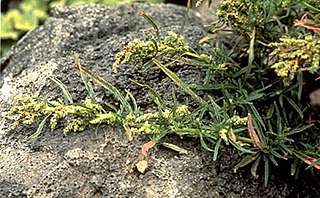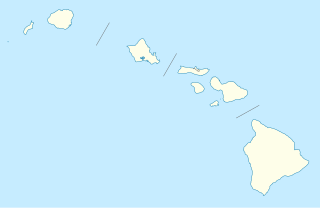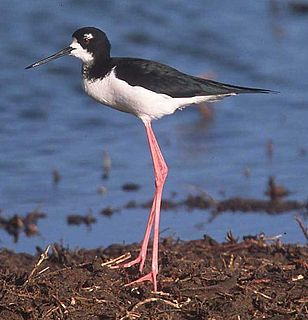
The Hawaiian crow or ʻalalā is a species of bird in the crow family, Corvidae, that is currently extinct in the wild, though reintroduction programs are underway. It is about the size of the carrion crow at 48–50 cm (19–20 in) in length, but with more rounded wings and a much thicker bill. It has soft, brownish-black plumage and long, bristly throat feathers; the feet, legs and bill are black. Today, the Hawaiian crow is considered the most endangered of the family Corvidae. They are recorded to have lived up to 18 years in the wild, and 28 years in captivity. Some Native Hawaiians consider the Hawaiian crow an ʻaumakua.

The ʻiʻiwi or scarlet honeycreeper is a species of Hawaiian honeycreeper. The ʻiʻiwi is a highly recognizable symbol of Hawaiʻi. The ʻiʻiwi is the third most common native land bird in the Hawaiian Islands.

Solanum nelsonii, common names pōpolo and Nelson's horsenettle, is a partially woody sprawling shrub-like perennial plant in the family Solanaceae, part of the Solanum or nightshade genus. This poisonous plant is endemic to the Pacific Islands. It grows low in coastal sites in coral rubble to pure sand.

Amaranthus brownii was an annual herb in the family Amaranthaceae. The plant was found only on the small island of Nihoa in the Northwestern Hawaiian Islands, growing on rocky outcrops at altitudes of 120–215 m (394–705 ft). It was one of nine species of Amaranthus in the Hawaiian Islands, as well as the only endemic Hawaiian species of the genus. It is now considered extinct.
Pritchardia lanaiensis, the Lānaʻi pritchardia, is a species of fan palm that is endemic to Hawaii in the United States. It can only be found on the island of Lānaʻi.

Dracaena fernaldii, synonym Pleomele fernaldii, is a species of flowering plant that is endemic to the island of Lānaʻi in Hawaiʻi. It is known by the common name Lanai hala pepe. It can be found in dry forests at elevations of 490–670 metres (1,610–2,200 ft). It is threatened by habitat loss. 400-1000 of these plants remain in the wild, but little recruitment has been observed in the past 10 years. The reasons for the lack of recruitment are unclear.

The Maui ʻakepa is a species of ʻakepa native to Maui in the Hawaiian Islands, and which was common throughout the island. Introduced mosquitoes and other animals to Maui contributed to the declining population, and the bird is considered Critically Endangered or possibly extinct by the IUCN Red List of Threatened Species. The latest reported sighting of this bird was in 1988, and in 2021 the United States Fish and Wildlife Service declared it extinct.

The Maui nukupuʻu was a species of nukupu‘u Hawaiian honeycreeper that was endemic to the island of Maui in the Hawaiian Islands. The small, five-inch-long bird lived only in eastern Maui, where it was dependent on high-elevation mesic and wet forests of ʻōhiʻa lehua and koa. These two species of trees attract insects, causing the Maui nukupuʻu to have a higher chance of finding a meal near these trees. It was last sighted in the late 1990's, and is most likely extinct.

Gahnia is a genus of sedges native to China, Southeast Asia, New Guinea, Australia, New Zealand and a number of Pacific Islands. The common name is due to the toothed margins. It often forms tussocks.
Phyllostegia hispida, the hispid phyllostegia, is an endangered species of flowering plant in the mint family, Lamiaceae. It is found only in wet forests at elevations of 2,300–4,200 feet (700–1,280 m) on the island of Molokaʻi in Hawaiʻi. This green vine's loosely spreading branches often form a large mass.

The Pearl Harbor National Wildlife Refuge is a National Wildlife Refuge on the island of Oʻahu, Hawaii. It was created in 1972 to mitigate the wildlife resource disturbances caused by construction of the Honolulu International Airport Reef Runway. The Refuge includes three units, the Honouliuli, Waiwa and Kalaeloa. The Honouliuli and Waiawa Units are managed under a cooperative agreement with the United States Navy. The Kalaeloa Unit was established during Base Realignment and Closure proceedings in 2001. Through these cooperative efforts with the Federal Aviation Administration, the State of Hawaii, and the U.S. Navy, the U.S. Fish and Wildlife Service made Pearl Harbor NWR a reality.

Bidens micrantha is a species of flowering plant in the aster family known by the common name grassland beggarticks. It is endemic to the Hawaiian Islands, where it and other Bidens species are known as kōʻokoʻolau. It occurs in many types of habitat on Lānaʻi, Maui, and Hawaiʻi, including rocky cliffs, dry forests, mesic forests, wet forests, and high shrublands.
Clermontia oblongifolia is a species of flowering plant in the bellflower family known by the common name Oahu clermontia. It is one of several Hawaiian lobelioids in genus Clermontia that are known as ʻoha wai. This plant is native to three of the Hawaiian Islands, where one subspecies is not uncommon but the other two are very rare and endangered.

Kadua cordata is a species of flowering plant in the coffee family known by the common name kopa. It is endemic to Hawaii.
Phyllostegia hirsuta is a species of flowering plant in the mint family known by the common names Molokai phyllostegia and hairy phyllostegia. It is endemic to Hawaii, where it is known only from the island of Oahu. It is a federally listed endangered species of the United States.

Phyllostegia parviflora is a rare species of flowering plant in the mint family known by the common name smallflower phyllostegia. It is endemic to Hawaii, where it is known from Maui, Oahu, and the island of Hawaii. It is a federally listed endangered species of the United States.
Viola lanaiensis is a rare species of flowering plant in the violet family known by the common name Hawaii violet. It is endemic to Hawaii, where it is known only from the island of Lanai. It is threatened by deer, sheep, and introduced species of plants. It is a federally listed endangered species of the United States.

The Hawaiian stilt is an endangered Hawaiian subspecies of the black-necked stilt species. It is a long-legged, slender shorebird with a long, thin beak. Other common names include the Hawaiian black-necked stilt, the aeʻo, the kukuluaeʻo, or it may be referred to as the Hawaiian subspecies of the black-necked stilt.
Haplostachys (honohono) is a genus of flowering plants in the mint family, Lamiaceae, first described as a genus in 1888. The entire genus is endemic to the Hawaiian Islands, although 4 of the 5 known species that have been placed in the genus are now believed to be extinct, the fifth listed as "Critically Imperiled."













